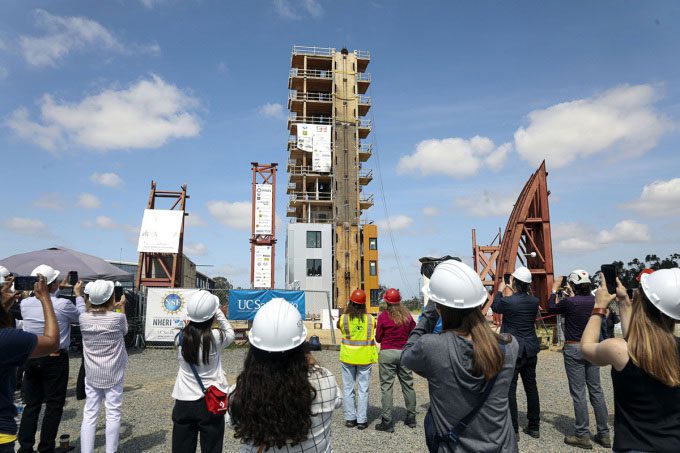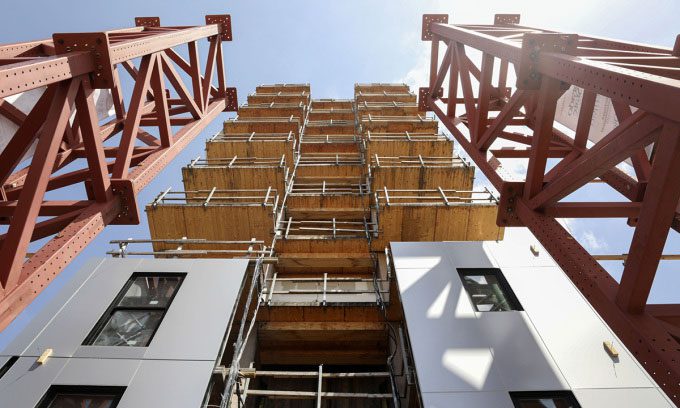The wooden building was constructed to full scale, standing on a test platform measuring 93m2 and remained stable after multiple simulated earthquake shakes.

The TallWood wooden building undergoing tests on a “shake table” in San Diego last May. (Photo: Sandy Huffaker/Bloomberg)
The 34-meter tall wooden building is the tallest structure ever subjected to simulated earthquakes on the world’s largest high-performance shake table, which uses hydraulic actuators to move a steel platform to replicate seismic forces. The shake table tests took place at the University of California, San Diego, as part of the TallWood Project, Bloomberg reported on June 6.
The TallWood Project aims to test the seismic resilience of tall buildings made from cross-laminated timber (CLT) – a material composed of multiple layers of wood glued together. CLT is increasingly gaining popularity as a more sustainable alternative to high carbon-emitting concrete and steel.
The 10-story wooden building has undergone over 100 earthquake simulations, a number that is expected to increase before the testing concludes in August. “The building is experiencing the number of earthquakes that it would never encounter in reality unless it existed for about 5,000 years,” said Thomas Robinson, founder of Lever Architecture, the American firm involved in the design of the TallWood structure.
The first three floors of the 34-meter building are clad with orange and silver panels around the glass windows. The remaining part of the building is left exposed, with each floor featuring four lateral shake walls designed to minimize structural damage during earthquakes. The engineering team also designed the interior walls and staircase to withstand strong shaking and installed sensors throughout the building. Two five-story metal protective towers are located on one side, and cables anchor the building to the ground on the opposite side to prevent it from toppling during testing.

The protective towers of the wooden building during testing. (Photo: Sandy Huffaker/Bloomberg).
On a May morning, engineers programmed the shake table to recreate two earthquake disasters. The first was the 6.7 magnitude earthquake in Los Angeles in 1994. In just 20 seconds, the disaster caused more than $40 billion in damages as buildings and highways collapsed, resulting in 60 fatalities. The second was the 7.7 magnitude earthquake in Taiwan in 1999, which destroyed many concrete and steel skyscrapers and claimed over 2,400 lives.
After half an hour, experts deemed the building safe enough to enter. Shiling Pei, the lead investigator of the TallWood Project and an associate professor of civil and environmental engineering at Colorado School of Mines, inspected the walls and floors of the third floor. “This is precisely the outcome we expected, with no structural damage. This means the building can quickly be put back into use,” Pei stated.
According to Robinson, avoiding costly structural repairs and quickly bringing buildings back into operation helps reduce the economic and social impacts of earthquakes. He also noted that the outer walls of the TallWood building remained straight despite the intense shaking.
When the earthquake testing concludes, the building will be dismantled, and its components will be recycled to construct other test facilities. The research team hopes the results of the tests will encourage the construction of more tall cross-laminated timber buildings, as they have demonstrated their robustness.



















































